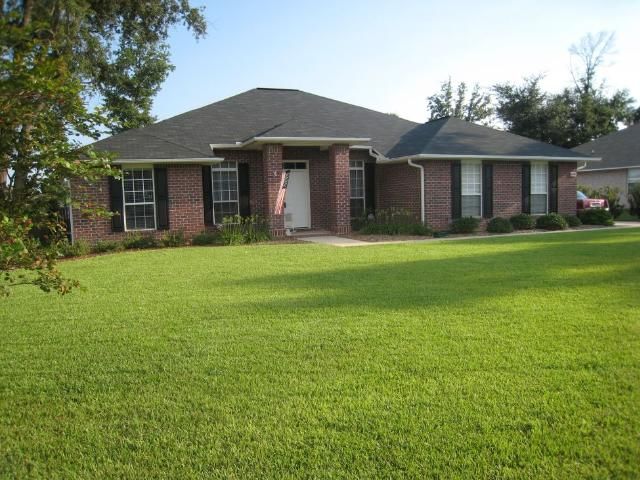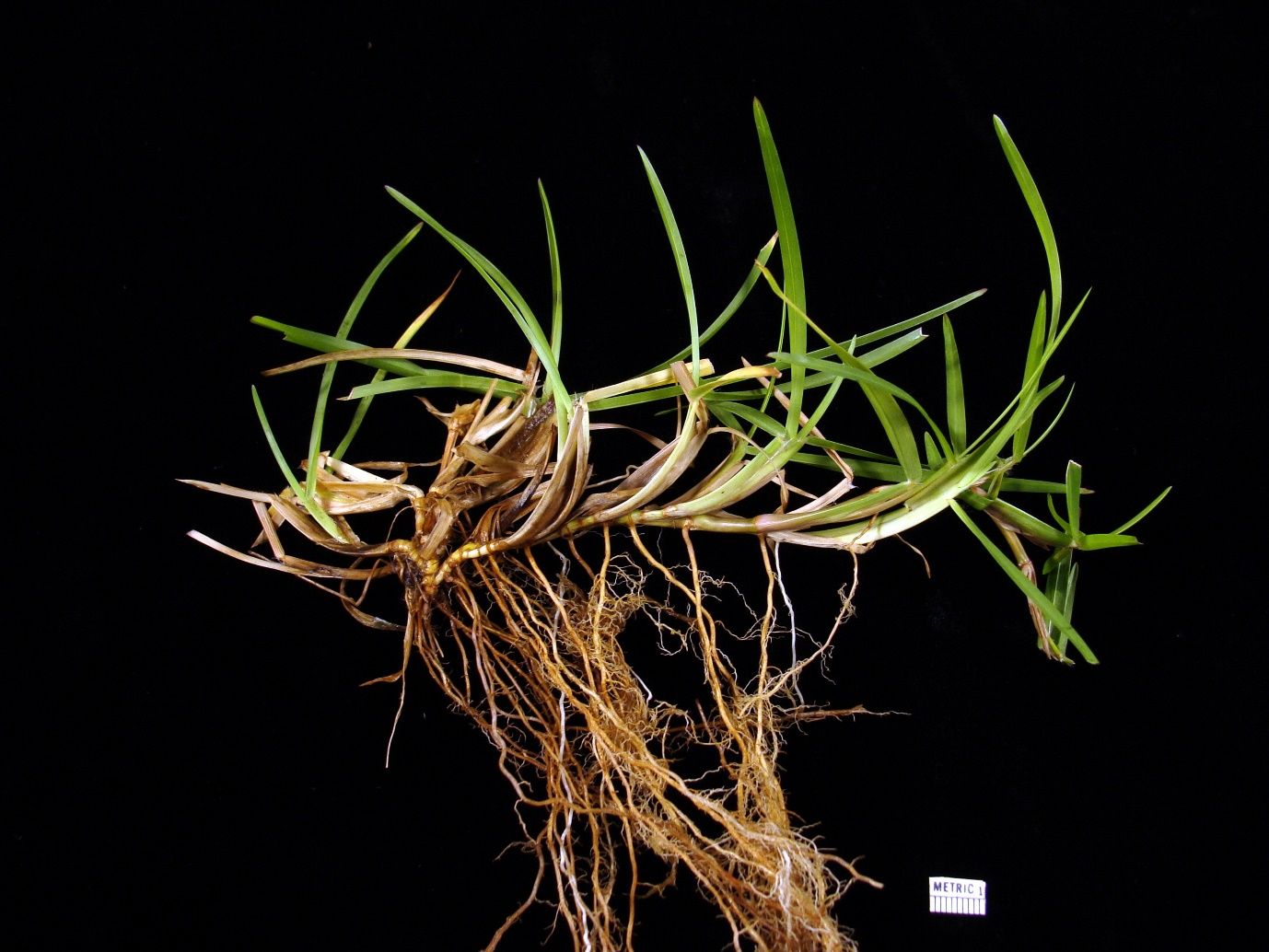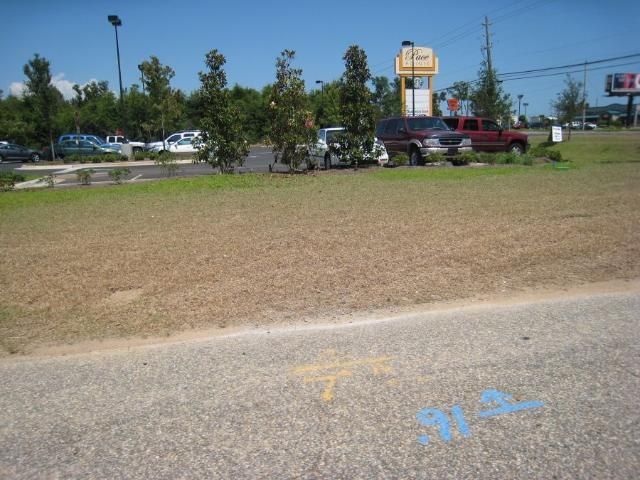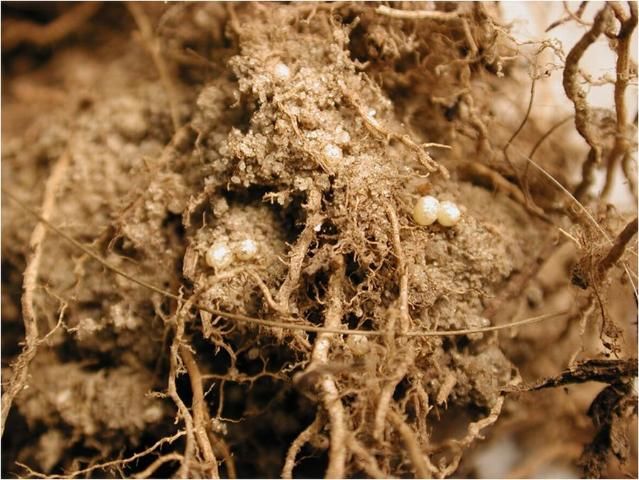Centipedegrass (Eremochloa ophiuroides [Munro] Hack.) was introduced into the United States from southeastern Asia in 1916. It is well adapted to the climate and soils of Central and Northern Florida and is the most common home lawn grass in the Florida Panhandle (Figure 1). This publication is intended for those producing and maintaining centipedegrass. Table 1 provides a generalized comparison of lawn grasses available for use throughout Florida.
Table 1. Generalized species comparisons of lawn grasses available for use throughout Florida.

Credit: J. Bryan Unruh, UF/IFAS
Centipedegrass is a slow-growing grass with low fertility requirements when compared to other Florida lawn grasses. Centipedegrass grows close to the ground and spreads by aboveground stems (stolons) that root at the nodes (Figure 2). Centipedegrass leaves are medium textured, measuring 3–5 millimeters wide, and smooth, with margins that are hairy toward the base. It is naturally lighter in color than other lawn grasses.

Credit: Jason Kruse, UF/IFAS
Overfertilizing with nitrogen to obtain a dark green color reduces its cold tolerance, increases long-term maintenance problems, and is believed to contribute to centipedegrass decline, a disease complex that produces patches of dead turf in the spring.
Advantages
Centipedegrass does well in acidic (pH 4.5–6.5) and infertile soils. It has fair shade tolerance (requires more sunlight than St. Augustinegrass but less than bermudagrass) and survives drought conditions by going dormant, which results in brown turf (Figure 3). It can be established from seed, sod, or plugs, and it spreads by aboveground stems called stolons. Maintenance and fertility requirements are low compared to other turfgrasses.

Credit: J. Bryan Unruh, UF/IFAS
Disadvantages
Centipedegrass is susceptible to damage from plant-parasitic nematodes (especially ring nematodes) and the scale insect known as ground pearls (Figure 4). Historically, nematode damage limited the use of centipedegrass in South Florida's sandy soils. Most centipedegrass cultivars have a naturally pale yellow-green color and are prone to iron chlorosis (yellowing of leaf blades). It has poor salt, wear, and freeze tolerance. Centipedegrass stolons have high lignin content, which resists breakdown and decay, and contribute to a heavy thatch layer, particularly when high nitrogen fertilization rates are applied. The grass is often subject to centipedegrass decline, a fungal disease caused by Gaeumannomyces graminis var. graminis. The decline is influenced by improper management practices, particularly high nitrogen fertility. Intensive management over a period of multiple years may result in root dieback in the spring. This root dieback then reduces shoot growth and results in the death of large patches of the lawn. This condition is aggravated by thatch accumulation, resulting in new stolons growing above the soil surface and on top of the thatch layer. These stolons rarely root down and are prone to injury from drying and cold temperatures. Management practices that can encourage root growth include irrigating properly, maintaining a mowing height of 1.5–2.5 inches, preventing thatch accumulation, and ensuring low nitrogen fertility rates.

Credit: J. Bryan Unruh, UF/IFAS
Cultivars
Because of a relatively small region of use, few centipedegrass varieties have been developed. Following is a list of varieties that are available as of this writing.
Common
Common centipedegrass is a term used to describe an undeveloped and unimproved population of centipedegrass. This variety can be established by seed or vegetative means and is available from many sod producers. It grows slowly and in a prostrate manner.
'Covington'
'Covington' centipedegrass is a new proprietary selection from Sod Solutions, Inc. (http://www.sodsolutions.com). 'Covington' leaves, stems, and seed heads are uniformly emerald green in color. 'Covington' has good fall color retention and stays green several weeks longer than other centipede varieties. This variety is currently being evaluated by UF/IFAS.
'Santee'
'Santee' is a proprietary selection from Sod Solutions, Inc., with limited production in Florida.
'TifBlair'
'TifBlair' was released by the University of Georgia in 1997. It has good cold and freeze tolerance and can be propagated by seed or vegetative means. It has a slightly faster rate of growth than other centipedegrass cultivars. ‘TifBlair’ was licensed to The Turfgrass Group, Inc. (https://theturfgrassgroup.com/variety/tifblair-centipede/) for sod production and is available only from qualified, licensed producers.
Establishment of Centipedegrass
Proper site preparation before planting is critical to ensure successful establishment. Refer to EDIS publication #ENH02, “Preparing to Plant a Florida Lawn" (https://edis.ifas.ufl.edu/lh012), for complete information on how to do so. Specifically, centipedegrass is best adapted to a low-pH soil. Severe iron chlorosis (yellowing) may occur if pH is above 6.5–7.0. Preplant application of wettable sulfur at the rate of 430 pounds per acre (10 pounds per 1000 square feet) can be used to reduce the pH of some Florida soils by 1 pH unit. Do not apply more than 10 pounds per 1000 square feet of wettable sulfur per application. Where more is required, allow 60 days between applications. Irrigate with 1 inch of water after each application to activate the sulfur. Lime is seldom required for centipedegrass. If soil pH is high, centipedegrass may not be an appropriate choice.
Centipedegrass can be established by seed, plugs, sprigs, or sod. Planting centipedegrass as sod produces an instant lawn that establishes more rapidly and is less susceptible to various stresses. Lay the sod on a well-prepared planting site, fitting the pieces tightly together to avoid gaps in the turf. Wet the soil surface thoroughly prior to laying the sod. After the sod is in place, roll with a lightweight roller to ensure firm contact between the sod and soil; water thoroughly. For more information on establishing a lawn, please refer to EDIS publication #ENH03, “Establishing Your Florida Lawn.” (https://doi.org/10.32473/edis-lh013-2010). Although sodding is more expensive than seeding or plugging, good-quality, weed-free sod produces the best quality lawn.
Centipedegrass seed is more costly than other types of grass seed, but the seeding rate is low. The suggested seeding rate is 4 ounces per 1000 square feet. Since the seeds are very small, mix the needed quantity of seed with 10–20 pounds of dry sand and spread this mix on the lawn. Seed quality should be considered when purchasing seed for planting. Insist on seed with a purity of 90% or better and a minimum of 85% germination. Centipedegrass seed that has been coated with germination-enhancing materials require a greater quantity of seed to achieve equal seed counts with uncoated seed.
The best time to seed is during the period from April to July, since this permits a full growing season before winter weather. Fall seeding is undesirable because the young seedlings may not become sufficiently established to withstand cold injury during the winter. Up-front costs associated with establishment of centipedegrass by seed are low; however, centipedegrass seed is naturally slow to germinate. It may take up to 2–3 weeks to germinate and an additional 6–8 weeks to establish. During this time, irrigation management is very important. After planting, water lightly every day for 2–3 weeks to keep the soil moist but not soggy. This may require multiple applications per day on sandy soils. Once the seeds have germinated, start to decrease the frequency of irrigation but increase the amount of water applied. Soil erosion due to heavy rain or excessive irrigation should be minimized by lightly mulching the planted area with weed-free grass, hay, or straw so that 50%–75% of the bare ground is protected.
Attempting to repair a dead area within an established centipedegrass lawn by reseeding is very difficult and generally requires hand watering for success. Using a sprinkler system to water the seeded areas can result in overwatering of established centipedegrass, which can lead to increased disease incidence.
Plugging or sprigging centipedegrass leaves open areas of soil that are subject to invasion by opportunistic weed species. Due to the slow growth habit of centipedegrass, weeds dominate, and the area should be scouted on a regular basis to remove weeds before they have a chance to gain hold. Irrigation requirements for newly plugged or sodded grass differ from those of established grass until a viable root system is established. For the first 7–10 days, irrigate with 2–3 brief spritzes (5–10 minutes each). For 7–10 days after that, irrigate once a day with ¼ inch of water. For the next week, irrigate every other day with ¼–½ inch of water. After that (approximately 30 days after planting), a regular maintenance irrigation schedule may be followed. Do not mow until the roots have had a chance to work down into the soil and establish themselves, generally 2–3 weeks after plugging/sodding. Gently tug on the plugs or sod to see if they have taken root. If they do not easily pull up, then mowing can commence.
Maintenance of Centipedegrass
Fertilization
Proper fertilization is very important for sustaining a healthy lawn. Fertilization and other cultural practices influence the overall health and quality of the lawn and reduce its vulnerability to numerous stresses, including weeds, insects, and disease. It is very important that anyone fertilizing their lawn be familiar with and follow the Florida Friendly Landscaping™ Best Management Practices (FFL BMPs). These practices are designed to maintain healthy lawns and reduce any potential nonpoint source pollution of water resources that might result from lawn and landscape fertilization and other cultural practices. There are now state and local regulations that cover lawn fertilization, so be aware of city and county guidelines and always follow the directions on the fertilizer bag. For more information on BMPs, please refer to EDIS publication #ENH979, “Homeowner Best Management Practices for the Home Lawn” (https://edis.ifas.ufl.edu/ep236).
A soil test should be done to determine soil pH and what nutrients are available to the lawn. An easy-to-use UF/IFAS soil test kit is now available at local Extension offices throughout Florida or online at https://soilkit.com/product/university-of-florida-soil-test-kit/. The local UF/IFAS Extension office also has instructions and supplies for taking soil samples. In particular, phosphorus levels are best determined by soil testing. Since many Florida soils are high in phosphorus, it is often not necessary to add phosphorus to a lawn once it is established.
Florida Rule (5E-1.003) mandates that fertilizer application rates cannot exceed 1 pound of nitrogen per 1000 square feet for any application. Based on the percentage of nitrogen that is in a slowly available or slow-release form in a fertilizer, UF recommendations call for applying a ½ pound (water-soluble nitrogen source) to 1 pound (slow-release nitrogen source) of nitrogen per 1000 square feet of turfgrass. For information on determining how much fertilizer this equals and how to apply the correct amounts, please refer to ENH962, “Figuring out Fertilizer for the Home Lawn” (https://doi.org/10.32473/edis-ep221-2009).
Established centipedegrass lawns require about 50% less nitrogen fertilizer than other lawn grasses grown in Florida. Centipedegrass is a low maintenance turfgrass and does not respond well to excessive use of fertilizer, especially nitrogen. Do not overfertilize centipedegrass with nitrogen to turn it darker green. Overfertilization of centipedegrass can result in centipedegrass decline disease, increased insect pressure, and thatch accumulation.
Fertilizer should be applied to centipedegrass in 1–3 applications from spring green-up through fall. Do not apply nitrogen too early in the growing season (before April 15th in North Florida) because late spring frosts may damage the grass. Likewise, do not fertilize too late in the year because this can slow regrowth the following spring. A general guideline for the last fertilizer application is mid-September for North Florida and early October for Central Florida. In South Florida, fertilizer applications may be made throughout the year since growth is year-round. See Table 2 for the fertilizer guidelines of each three regions of the state; all rates are in pounds of nitrogen per 1000 square feet.
UF/IFAS guidelines for lawn grass fertilization offer a range of fertilizer rates over which a particular species may be successfully maintained in the various regions of the state. These ranges account for individual homeowner preferences for low-, medium-, or higher-input grass. Additionally, localized microclimatic effects can have a tremendous effect on turfgrass growth. A range of rates allows for these environmental variations. An example of this would be a typical home lawn that is partially shaded and partially sunny. The grass growing in the shade needs less fertilizer than that growing in full sun. Fertilization is also affected by soil type, organic matter in soils, and practices such as clipping management. Recycled clippings provide some nutrients back to the turfgrass and may reduce the need for fertilizer inputs. Additionally, a newly sodded lawn on a sand soil with no organic matter may need more fertilizer than a lawn that has been fertilized for years. In Florida, new homes and new developments may be next to much older developed landscapes, and a one-size-fits-all approach to fertilization is not reasonable. Thus, the guidelines provide a base range from which the end user can begin a fertilization program. The homeowner is encouraged to initiate a program based on these guidelines and to adjust it over time based on how the turfgrass responds.
As mentioned previously, one of the common problems of centipedegrass is leaf yellowing called chlorosis, which is usually caused by iron deficiency. This condition is most severe where soil pH is above 6.5 or where the soil contains large quantities of calcium or phosphorus. This yellowing is generally worst in early spring when daytime temperatures are warm but nighttime temperatures are still cool. Warm daytime air temperatures promote leaf and stolon growth, but cool nighttime temperatures limit root growth. The roots cannot take up enough nutrients to supply the growing leaves, causing them to turn yellow. As soil becomes warmer, this temporary nutrient deficiency wanes.
Centipedegrass usually responds well to supplemental applications of iron. However, it is important to note that iron is not a substitute for nitrogen, which provides the building blocks for turfgrass growth and is required for turf health. While both iron and nitrogen deficiencies result in yellowing of turfgrass, they are distinctly different deficiencies in plants. Applying iron does not cure yellowing of turfgrass due to nitrogen deficiency, and iron fertilizer is not a substitute for nitrogen fertilizer. Foliar iron fertilizers, such as iron sulfate or chelated iron solutions, help correct iron deficiencies, and nitrogen fertilizers applied according to BMPs correct nitrogen deficiencies. Chelated or ferrous sulfate iron can be applied evenly and easily with a hose-end applicator. Apply the ferrous sulfate at the rate of 2 ounces in 3–5 gallons of water per 1000 square feet. Consult the label for chelated iron rates. Granular fertilizers containing iron as an ingredient are also available but are generally less effective in Florida soils.
Mowing
Proper mowing practices are necessary to keep any lawn healthy and attractive. Centipedegrass that is actively growing should be mowed every 7–14 days at a height of 1.5–2.5 inches. Mowing at this height promotes a deeper, more extensive root system that enables the grass to better withstand drought and nematode stress. Remove no more than 1/3 of the height of the leaf blades with any mowing (e.g., for a lawn to be maintained at 2 inches in height, mow when the turf reaches 3 inches).
Clippings should be left on the ground after mowing. They do not contribute to thatch buildup, as is often assumed, but are readily degraded by microorganisms. A sharp and well-adjusted rotary mower should be used.
Watering
Most lawn grasses will persist in the absence of rain or irrigation. However, the aesthetics will decline and may become unacceptable as the turfgrass transitions from green to blue-gray to yellow to brown in color. When supplemental irrigation is used, watering on an as-needed basis when drought symptoms occur is the best way to irrigate any established, mature grass, as long as the proper amount of water is applied when needed. Drought symptoms on lawn grasses generally appear as folded or wilted leaf blades that turn blue gray in color. Additionally, footprints may remain visible after walking on the grass.
When irrigating, apply ½–¾ inch of water per application. This applies water to roughly the top 8 inches of soil where most of the roots are. Be sure to follow any local watering restrictions. Refer to EDIS publication #ENH9, “Watering Your Florida Lawn” (https://edis.ifas.ufl.edu/lh025), for additional information about proper watering techniques.
To determine the amount of irrigation supplied by a sprinkler system, place several straight-sided cans (e.g., tuna fish or cat food) throughout each irrigation zone and run each zone to determine how long it takes to fill the cans to the ½–¾-inch level, then record the time. Each zone will likely take different amounts of time to give the same quantity of water. The recorded run times for each zone should then be programmed into the irrigation clock for automated systems. If the variation in the catch cans is high, a more thorough audit of the irrigation system is needed.
During prolonged droughts, irrigation may be needed more often. Centipedegrass, however, has good drought tolerance and usually recovers from severe drought injury soon after rain or irrigation. Do not overwater centipedegrass lawns as this weakens the turf and encourages weeds. Refer to EDIS publication #ENH9, “Watering Your Florida Lawn” (https://edis.ifas.ufl.edu/lh025), for additional information.
Pest Management
Centipedegrass can be damaged by nematodes, insects, and diseases. Obtain help in identification of pest problems and current control recommendations from the local UF/IFAS Extension office (http://sfyl.ifas.ufl.edu/find-your-local-office/).
Weeds
Weeds easily invade newly established or poorly maintained lawns. Grass weeds include crabgrass, goosegrass, dallisgrass, annual bluegrass, and torpedograss, among others. Broadleaf weeds include dandelions, clover, pennywort, betony, oxalis, henbit, and others. Refer to EDIS publication #ENH884, “Weed Management in Home Lawns” (https://edis.ifas.ufl.edu/ep141), for more information.
Insects
Several insects may damage centipedegrass, but the hardest to control are scale insects called ground pearls for which there are no effective control products. Lawn caterpillars, grubs, mole crickets, spittlebugs, and sod webworms also damage centipedegrass. For more information, refer to EDIS publication #CIR427, “Insect Management in Your Florida Lawn” (https://doi.org/10.32473/edis-lh034-2006).
Diseases
As previously mentioned, the principal disease affecting centipedegrass is centipedegrass decline (Gaeumannomyces graminis var. graminis), which can be minimized by following the proper cultural practices. Large (brown) patch (Rhizoctonia spp.) and dollar spot (Clarireedia jacksonii) can be sporadic problems, and both can be minimized by following proper nutrition and controlled with fungicides. For more information, refer to EDIS publication #PP233, “Homeowner's Guide to Fungicides for Lawn and Landscape Disease Management” (https://edis.ifas.ufl.edu/pp154).
Nematodes
Nematodes can be a very serious threat to centipedegrass. These are microscopic worms that attack grass roots, causing the lawn to thin and eventually die. Areas of heavy infestation show symptoms of severe wilt, even when well-watered. The UF/IFAS Nematode Assay Laboratory in Gainesville can diagnose whether nematodes are a problem by looking at a soil sample taken from the margin of the affected area. Proper cultural factors to encourage centipedegrass root growth will lessen nematode stress. These include applying less nitrogen, providing less frequent but deep watering, and ensuring adequate soil potassium and phosphorus. Refer to EDIS publication #ENY006, “Nematode Management in Residential Lawns” (https://edis.ifas.ufl.edu/ng039), for additional information.
Centipedegrass Decline
After a few years, centipedegrass may develop yellowing (chlorosis) and/or dead spots as spring growth resumes. Numerous conditions may contribute to the problem and include the following:
- High pH (> 6.5)
- Excessive nitrogen fertilization in prior years
- Uneven soil surface from stolons being elevated above the soil and over a mat of thatch (Such stolons never sufficiently develop roots and are killed by freezing weather. Alternating freezing or cool temperatures and thawing conditions exacerbate the problem.)
- Root dieback or any environmental conditions that may stress roots, such as soil compaction, improper mowing heights, overirrigation, etc.
- Nematodes and/or disease organisms, such as Gaeumannomyces spp., Rhizoctonia spp., or Pythium spp., which weaken the grass, making it susceptible to injury from otherwise normal conditions.
Some remedies for this condition are as follows:
- Check soil pH and adjust it if it is too high.
- Do not overfertilize with nitrogen.
- Follow recommended mowing heights and frequencies to avoid scalping or excessive thatch buildup.
- Spray with 2 ounces ferrous sulfate per 1000 square feet, or use chelated iron as directed by the label if excessive yellowing occurs.
- Consult a UF/IFAS Extension agent to send samples for identification of nematodes and diseases.
Table 2. Annual nitrogen fertilizer recommendations for centipedegrass in three regions of Florida.